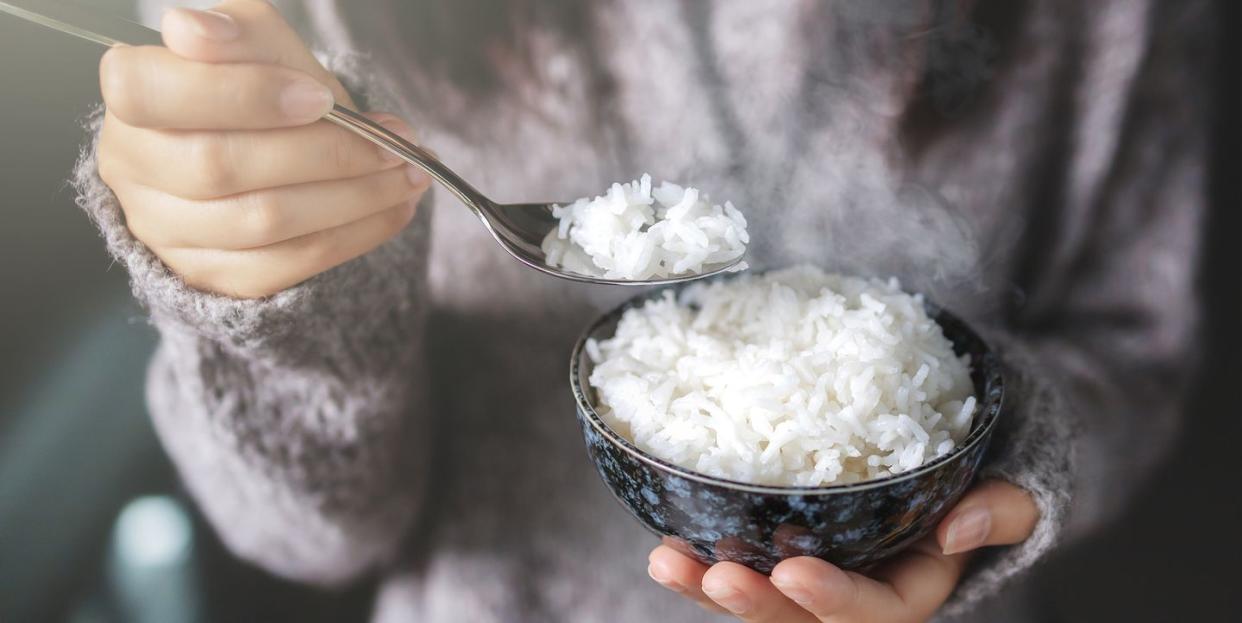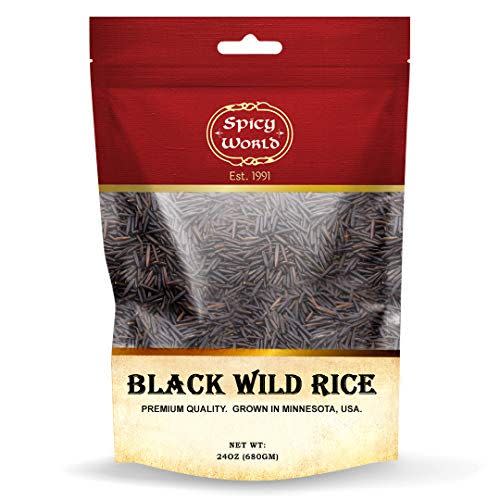Don't Miss Out On These Major Health Perks Of Rice Because Of The Carb Count

"Hearst Magazines and Yahoo may earn commission or revenue on some items through these links."
Rice is hands down one of the best side dishes ever—it goes with just about every type of cuisine. But is rice good for you, nutritionally speaking, and how much of it should you be eating regularly?
First, let's get to know rice a little bit better. It's a type of grain, like barley, oats, and wheat, according to the National Institute on Aging (NIA), and ICYMI, grains are the body’s main source of energy and fuel.
And the history of rice goes way back. Many cultures have evidence of early rice cultivation, including China, India, and the civilizations of Southeast Asia. However, the earliest archaeological evidence comes from central and eastern China that dates to 7000 to 5000 BC.
Nowadays, rice is a staple in more than 100 countries, according to a 2018 study published in the Journal of the Science of Food and Agriculture. In some households, it is included in more than one meal a day, and for good reason—this starchy grain is higher in calories and generally available at a low cost, making it accessible to most people.
Each country has a rice dish featuring that region’s local spices and culinary preferences of its people. For example, there's coconut rice in Colombia, jambalaya in the U.S., paella in Spain, rice and beans in Mexico, risotto in Italy, fried rice in China, and sweet rice in Portugal, per Harvard T.H. Chan School of Public Health.
You definitely don't want to miss out on having this healthy staple in your diet. “It's an inexpensive, minimally refined complex carbohydrate that provides energy," says Constance Weissmuller, RDN, the owner of Constance Weissmuller Nutrition Therapy. That said, not all rice is created equal, and some varieties are better for you than others. Here, nutrition experts break down everything you need to know about rice, including its health benefits, how to choose the right kind for you, and the appropriate amount to have.
Meet the experts: Constance Weissmuller is a nutritionist based in Denver, Colorado. May Zhu is a nutritionist based in Chicago, Illinois.
Types of Rice
Rice is often broadly categorized based on its shape and method of processing. This is why length is so important. It helps you determine what type of rice is best suited for your preferred cooking method and the recipe you are making.
Here's the breakdown of rice by length.
Long-grain rice has a slender kernel and are over four times as long as it is wide. When cooked, long-grain rice stays fluffy and separate. Examples include basmati and jasmine rice.
Medium-grain rice has a shorter, wider kernel and turns into a semi-sticky yet tender consistency when cooked. An example is Arborio rice.
Lastly, short-grain rice has a kernel only twice as long as it is wide and yields the stickiest texture once cooked. This is why short-grain rice is most commonly used for sushi.
Rice can also come in refined and whole-grain forms. Brown rice is a type of whole-grain rice, as it contains three edible parts: the bran, germ, and endosperm. (This is true of all whole grains). The name describes not a particular variety of rice but the natural color of the grain. Whole-grain rice is not limited to just one color and can come in various shades like black, purple, and red.
Since the fibrous bran layer and nutrient-rich germ remain intact, these whole-grain rice varieties, like brown rice, typically take longer to cook and have a chewier texture and nuttier taste than refined white rice.
On the other hand, white rice is a type of refined rice that has been polished to remove the bran layers and embryo so only the starchy white endosperm remains, hence the name. The milling and polishing processes remove the majority of B vitamins, fiber, minerals, and phytochemicals naturally found in rice. Sometimes B vitamins and iron are added back into white rice and food labels will display the term “enriched.” Keep in mind, though, that only a small fraction of the original amount of these nutrients is added back.
What type of rice is best for you?
Whole-grain varieties contain the most nutrients, which include fiber, magnesium, manganese, phosphorus, selenium, and vitamins B1 (thiamin) and B6, according to Harvard T.H. Chan School of Public Health.
If you want to get the most bang for your buck with a solid serving of nutrition, it's best to stick with whole-grain rice, such as black, brown, red, and wild rice.

Black Wild Rice
$14.99
amazon.com
Wild rice, in particular, is high in fiber and minerals and contains slightly more protein than brown rice. It also has an earthy and nutty flavor that pairs well with milder seasonings and spices and mixes well with other grains.
So, is eating rice good for you?
The average human body needs over 200 grams of carbohydrates each day to function optimally, says Weissmuller. Both white and brown rice can be great choices for fulfilling part of that need.
B vitamins, which whole-grain rice is rich in, play a role in a variety of functions throughout the body and helps enzymes perform many different jobs, such as cell growth and functioning, the breakdown of macronutrients, and DNA repair, she says.
Whole grains are also helpful in maintaining healthy cholesterol levels and promoting stability in your blood sugar, as fiber takes longer to digest. “Fiber is considered a prebiotic, which aids in fecal bulk and is a compound that our gut bacteria enjoy eating to produce essential vitamins within our lower GI tract," says Weissmuller. "Most Americans do not eat enough fiber throughout the day and consuming brown rice is a great way to add a few grams in.”
Though its fiber content is not as impressive since the outer bran layer is removed, white rice still provides energy and some B vitamins. Additionally, some people may have trouble digesting a lot of fiber or prefer the taste and texture of white rice.
So yes, rice is good for you. Just remember to include it as a part of a well-balanced diet along with other foods like fresh fruits, protein, and vegetables.
Is rice good for weight loss?
“There is no evidence that rice on its own is directly related to weight gain and there is no one single food that solely contributes to weight gain or loss,” says Zhu. “Instead, it's about the overall total quality of food choices we make over time and eating balanced portions that are right for your body.”
Just remember: Moderation is key.
Okay, this seems like a silly question, but are there any disadvantages to eating rice?
There are some concerns in the media regarding arsenic levels in rice. However, the FDA has not found any scientific basis for consumers to swear off rice altogether, Zhu says.
“As a dietitian, we love recommending variety when it comes to whole grains. As long as rice is consumed in a balanced diet along with other varieties of grains such as barley, oats, and quinoa in a rotation, then it can definitely have a place as a part of a healthy lifestyle," she adds.
You Might Also Like

